Palais-Royal
| Palais-Royal | |
|---|---|
Conseil d'État, Ministry of Culture, Constitutional Council | |
| Construction started | 1633 |
| Completed | 1639 |
| Renovated | 1698–1700; 1719–1729; 1753–1779; 1782–1783; 1791–1793; 1828–1830 |
| Client | Cardinal Richelieu |
| Design and construction | |
| Architect(s) | |
| Website | |
| domaine-palais-royal | |
The Palais-Royal (French pronunciation: [pa.lɛ ʁwa.jal]) is a former French royal palace located on Rue Saint-Honoré in the 1st arrondissement of Paris. The screened entrance court faces the Place du Palais-Royal, opposite the Louvre. Originally called the Palais-Cardinal, it was built for Cardinal Richelieu from about 1633 to 1639 by architect Jacques Lemercier. Richelieu bequeathed it to Louis XIII, before Louis XIV gave it to his younger brother, the Duke of Orléans. As the succeeding Dukes of Orléans made such extensive alterations over the years, almost nothing remains of Lemercier's original design.
The Palais-Royal now serves as the seat of the
History
Palais-Cardinal
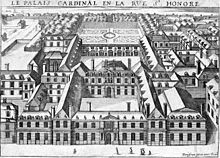
Originally called the Palais-Cardinal, the palace was the personal residence of Cardinal Richelieu.[1] The architect Jacques Lemercier began his design in 1629;[2] Construction commenced in 1633 and was completed in 1639.[1] The gardens were begun in 1629 by Jean Le Nôtre (father of André Le Nôtre), Simon Bouchard, and Pierre I Desgots, to a design created by Jacques Boyceau.[3] Upon Richelieu's death in 1642 the palace became the property of the King and acquired the new name Palais-Royal.[1]
After
.From 1649, the palace was the residence of the exiled
The Palais Brion, a separate section near the rue de Richelieu to the west of the Palais-Royal, was purchased by Louis XIV from the heirs of
Philippe I, Duke of Orléans

Henrietta Anne was married to Louis' younger brother,
The palace was redecorated and new apartments were created for the Duchess's maids and staff. Several of the women who later came to be
The
After Henrietta Anne died in 1670 the Duke took a second wife, the

The
About 1674 the Duke of Orléans had
After the dismissal of
In 1692, on the occasion of the marriage of the duc de Chartres to Françoise Marie de Bourbon, Mademoiselle de Blois, a legitimised daughter of Louis XIV and Madame de Montespan, the King deeded the Palais-Royal to his brother. The new couple did not occupy the northeast wing, where Anne of Austria had originally lived, but instead chose to reside in the Palais Brion. For the convenience of the bride, new apartments were built and furnished in the wing facing east on the rue de Richelieu.[6]
It was at this time that Philippe commissioned a Grande Galerie along the rue de Richelieu for his famous Orleans Collection of paintings, which was easily accessible to the public. Designed by the architect Jules Hardouin-Mansart,[10] it was constructed around 1698–1700 and painted with Virgilian subjects by Coypel. The cost of this reconstruction totaled about 400,000 livres.[11] Hardouin-Mansart's assistant, François d'Orbay, prepared a general site plan, showing the Palais-Royal before these alterations were made.
Philippe II, Duke of Orléans
When the Duke of Orléans died in 1701, his son became the head of the
At the death of Louis XIV in 1715, his five-year-old great-grandson succeeded him. The Duke of Orléans became Regent for the young
He commissioned
Louis d'Orléans
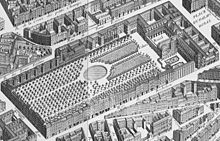
After the Regency, the social life of the palace became much more subdued. Louis XV moved the court back to Versailles and Paris was again ignored. The same happened with the Palais-Royal. Louis d'Orléans succeeded his father as the new Duke of Orléans in 1723. He and his son Louis Philippe lived at the other family residence in Saint-Cloud, which had been empty since the death of the Princess Palatine in 1722.
Claude Desgots redesigned the gardens of the Palais-Royal in 1729.[14]
Louis Philippe I
In 1752
Louis Philippe II
Theatres of the Palais-Royal

The Palais-Royal had contained one of the most important public theatres in Paris, in the east wing on the
The Opera's theatre was destroyed by fire in 1763, but was rebuilt to the designs of architect
At the request of Louis Philippe II two new theatres were constructed in the Palais-Royal complex shortly after the fire. Both of these new theatres were designed by Victor Louis, the architect who also designed the shopping galleries facing the garden (see below). The first theatre, which opened on 23 October 1784, was a small puppet theatre in the northwest corner of the gardens at the intersection of the Galerie de Montpensier and the Galerie de Beaujolais.[19] Initially it was known as the Théâtre des Beaujolais, then as the Théâtre Montansier, after which Victor Louis enlarged it for the performance of plays and operas. Later, beginning with the political turmoil of the Revolution, this theatre was known by a variety of other names. It was converted to a café with shows in 1812, but reopened as a theatre in 1831, when it acquired the name Théâtre du Palais-Royal, by which it is still known today.[20]
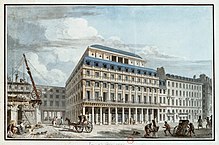

Louis Philippe II's second theatre was larger and located near the southwest corner of the complex, on the rue de Richelieu. He originally intended it for the Opera, but that company refused to move into it. Instead he offered it to the
Shopping arcades


Louis Philippe II also had Victor Louis build six-story apartment buildings with ground-floor colonnades facing the three sides of the palace garden between 1781 and 1784. On the outside of these wings three new streets were constructed in front of the houses that had formerly overlooked the garden: the rue de Montpensier on the west, rue de Beaujolais to the north, and rue de Valois on the east.[22] He commercialised the new complex by letting out the area under the colonnades to retailers and service-providers and in 1784 the shopping and entertainment complex opened to the public. Over a decade or so, sections of the Palais were transformed into shopping arcades that became the centre of 18th-century Parisian economic and social life.[23]
Though the main part of the palace (corps de logis) remained the private Orléans seat, the arcades surrounding its public gardens had 145 boutiques, cafés, salons, hair salons, bookshops, museums, and countless refreshment kiosks. These retail outlets sold luxury goods such as fine jewelry, furs, paintings and furniture to the wealthy elite. Stores were fitted with long glass windows which allowed the emerging middle-classes to window shop and indulge in fantasies. Thus, the Palais-Royal became one of the first of the new style of shopping arcades and became a popular venue for the wealthy to congregate, socialise and enjoy their leisure time. The redesigned palace complex became one of the most important marketplaces in Paris. It was frequented by the aristocracy, the middle classes, and the lower orders. It had a reputation as being a site of sophisticated conversation (revolving around the salons, cafés, and bookshops), shameless debauchery (it was a favorite haunt of local prostitutes), as well as a hotbed of Freemasonic activity.[24]
Designed to attract the genteel middle class, the Palais-Royal sold luxury goods at relatively high prices. However, prices were never a deterrent, as these new arcades came to be the place to shop and to be seen. Arcades offered shoppers the promise of an enclosed space away from the chaos that characterised the noisy, dirty streets; a warm, dry space away from the elements; and a safe-haven where people could socialise and spend their leisure time. Promenading in the arcades became a popular eighteenth century pastime for the emerging middle classes.[25]
From the 1780s to 1837, the palace was once again the centre of Parisian political and social intrigue and the site of the most popular cafés. The historic restaurant "
Dans ce jardin on ne rencontre
Ni prés, ni bois, ni fruits, ni fleurs.
Et si l'on y dérègle ses mœurs,
Au moins on y règle sa montre.[26]
("In this garden one encounters neither meadows, nor woods, nor fruits, nor flowers. And, if one upsets one's morality, at least one may reset one's watch.")
-
Design of 1781 by Victor Louis for the garden façade
-
The garden surrounded by the arcades in 2005
The Cirque du Palais-Royal, constructed in the center of the garden, has been described as "a huge half-subterranean spectacle space of food, entertainments, boutiques, and gaming that ran the length of the park and was the talk of the capital."[27] It was destroyed by fire on 15 December 1798.[28]
Inspired by the
-
View of the Palais Royal garden looking north in 1788 with the Cirque du Palais-Royal in the center
-
Plan of the Palais-Royal in 1795
Palais de l'Égalité and the Revolution

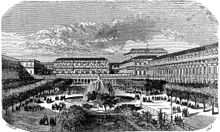
During the revolutionary period, Philippe d'Orléans became known as Philippe Égalité and ruled at the Palais de l'Égalité, as it was known during the more radical phase of the Revolution.[31] He had made himself popular in Paris when he opened the gardens of the palace to all Parisians. In one of the shops around the garden Charlotte Corday bought the knife she used to stab Jean-Paul Marat. Along the galeries, ladies of the night lingered, and smart gambling casinos were lodged in second-floor quarters.
The Marquis de Sade referred to the grounds in front of the palace in his Philosophy in the Bedroom (1795) as a place where progressive pamphlets were sold.
Upon the death of the Duke, the palace's ownership lapsed to the state, whence it was called Palais du Tribunat.[31] The Comédie-Française, the state theatre company, was reorganised by Napoleon in the décret de Moscou on 15 October 1812, which contains 87 articles.[32]
Bourbon restoration to Second Empire
After the Restoration of the Bourbons, at the Palais-Royal the young
The duke had Pierre-François-Léonard Fontaine draw up plans to complete work left unfinished by the duke's father. Fontaine's most significant work included the western wing of the Cour d'Honneur, the Aile Montpensier, and with Charles Percier, what was probably the most famous of Paris's covered arcades, the Galerie d'Orléans, enclosing the Cour d'Honneur on its north side. Both were completed in 1830. The Galerie d'Orléans was demolished in the 1930s, but its flanking rows of columns still stand between the Cour d'Honneur and the Palais-Royal Garden.[33]
In the
During the Second French Empire of
During the final days of
The Palais-Royal today

Today, the Palais-Royal is the home of the
South façade
-
The south front of the Palais-Royal, with the Conseil d'Etat (Council of State) in the center
The buildings of the Palais-Royal face south to the Place du Palais-Royal and the Louvre across the Rue de Rivoli. The central part of the Palace is occupied by the Conseil-d'État, or State Council. It has three floors, and is topped by a low cupola and a rounded pediment filled with sculpture. Two arched passages under the central building lead to the Courtyard of Honor behind. In the east wing, to the right, are offices of the Ministry of Culture and Communication. The two wings of the building have triangular fronts filled with sculpture, inspired by classical architecture and typical of the Louis XIV style.[36]
-
Sculpture of the Pediment of the Council of State
-
Sculpture of the south front, by Augustin Pajou
On the west side of the Council building is
Council of State
-
Napoleon on the Stairway of Honor (1807)
-
Stairway of Honor of the Conseil d'Etat, with trompe l'oeil painting of an arch and statue on first floor
-
Dome over the Stairway of Honor with gilded bursting pomegranate emblems of Philippe d'Orléans
-
Salle Napoleon, decorated 1858-60 for Ministry of Colonies of Napoleon III
-
General Assembly Chamber of the Council of State
-
Murals of the General Assembly Chamber, depicting France at work
-
Tribunal of Conflicts of the Council of State
-
Trompe l'oeil ceiling of the Tribunal of Conflicts
The
The Conseil has its own courtyard, facing out onto the Place du Palais-Royal and the Rue du Rivoli. Inside is the grand horseshoe stairway of honor, which curves upward along the walls to the landing on the first floor. It is decorated with theatrical effects, including ionic columns, and blind arches giving the illusion of bays. A trompe-l'oeil painting in an archway appears to give a view of a classical statue, above which
The most lavish room of the Council is the Hall of the Tribunal of Conflicts, a kind of courtroom installed in the former dining room of Duchess of Orleans, built by the architect Contant d'Ivry in 1753.
The General Assembly chamber was first a chapel, then, under Price Napoleon, a gallery of paintings. It has been changed more than any of the other rooms in the Council. At one end is a long table, with a seat in the center for the Vice President of the Assembly, who chairs the meetings, and the six presidents of the sections of Council. The decoration of the room is particularly rich and varied, with medallions and cameos and allegorical paintings illustrating the various codes of law and the administrative departments. Below these are four more recent large murals, installed between 1916 and 1926, on the theme of France at Work. They depict agriculture (workers in the fields), commerce (the Port of Marseilles), urban labor (Paris workers maintaining the Plae de la Concorde), and intellectual labor.[42]
Ministry of Culture
-
Wing occupied by the Ministry of Culture
-
Salon Jerome of the Ministry of Culture. named after Napoleon's brother
-
Office of the Minister of Culture
The office of the French Minister of Culture is located in the Palais-Royal, in an apartment originally built for the Duke and Duchess of Orleans in 1820, and later occupied by King
Constitutional Council
-
Stairway to the Constitutional Council
-
Office of the President of the Constitutional Council
-
Meeting room of the Constitutional Council
-
Petit Salon of the Constitutional Council
-
The Oratory, created by Princess Marie Clothilde
The
The grand stairway has two flights of stairs, each with a landing, while the first floor is surrounded by Ionic columns and topped with caisson vaults. Light comes from skylights in the vaults, reflected by rows of mirrors. A marble bust representing Rome, which originally was in the collection of Cardinal Richelieu, decorates the stairway landing. a modern addition is the chandelier made by
Courtyard of Honor
-
Courtyard of Honor, with installation of columns by Daniel Buren
-
Homage to Arago plaque, making the Paris meridian
-
The Courtyard of Honor, with the spheres of the Palais Royal fountain visible.
Behind the Council of State, and separated from the gardens by two rows of columns, which once were part of the Gallery of Orleans, is another courtyard, the Courtyard of Honor, which was created in the 18th century on a foundation made by Victor Louis. Three arcades in the center of the Council building mark the passageway to the front side of the building. The façade facing the courtyard has pairs of Ionic columns topped by a balustrade, decorated with four classical statues, each three meters high, representing Mars, Apollo, and allegorical figures of Prudence and Liberality by the sculptor
In 1985-86 the Ministry of Culture sponsored two sculptural works in the courtyard; the first, called "Photo-Souvenir - Les Deux Plateaux", by Daniel Buren, consists of short columns of various sizes arranged across the courtyard. The idea is to create two virtual platforms, without floors; the columns vary in height because of differences in height of the illusionary platforms; some of the column rows are purely horizontal, aligned to the height of the column bases of the gallery of Orleans, while the smaller columns all rise to the elevation of a lower non-existent platform; their variation in height is caused by the difference of elevation in parts of the courtyard. Each column has vertical bands of black and white.[46]
The second work is composed of two fountains by sculptor Pol Bury, located within the roofless Gallery of Orleans, which separates the Courtyard from the gardens. It consists of two square basins each containing seventeen polished metal spheres of different sizes, with water flowing around them. The polished spheres reflect the architecture of the arcades around them.
A third work, commissioned in 1994 is by the Dutch artist Jan Dibbets, passes through the courtyard of the Palais-Royal. It is called "Homage to Arago", and is a tribute to the French mathematician François Arago, who first conceived the prime meridian of Paris. the north–south line passing through the center of Paris which marked the prime meridian (rather than Greenwich) on French Maps. The work consists of one hundred thirty-five brass small brass plaques with the name "Arago" fixed on the pavement on a line which passes through the Palais Royal, and extends on the same axis to the north and south across Paris.[47]
Gardens
-
The noon cannon in the bowling green, triggered by the noontime sun
-
Fountain in the gardens
-
Paul Lemoyne, The Shepherd and the Goat (1830), marble
-
Gardens of the Palais-Royal
-
The Alley of Colette
The first garden of the Palais was planted by Cardinal Richelieu in 1629, where the Court of Honor is today. In 1633, Richelieu obtained authorisation to extend the garden northeast into the land occupied by the obsolete medieval city walls of Paris. He also received permission to sell forty-five building sites around the garden. The new garden site was 170 meters by 400 meters, making it the third largest garden in Paris, after the
The garden was redesigned several times, notably in 1674 by
A small cannon was installed in the middle of the bowling green at the north end of the garden in 1786. It fired a shot each day at noon, regulated by an ingenious mechanism that used a magnifying lens pointed at the sun's noontime position to light the match which fired the gunpowder. Between 1891 and 1911, the official noontime in France was defined by the cannon shot. It was stolen in 1998, but recovered and returned to its place in 2002.[49]
The two major alleys of the gardens are named for two of the famous 20th-century residents of the neighbouring buildings, the writers Colette and Jean Cocteau.
Town houses
-
Unified façade of town houses overlooking garden
-
Colette's town house entrance at 9 rue de Beaujolais
Near the end of the 18th century the architect Victor Louis designed rows of town houses on three sides of the garden, which extend 275 meters on the east and west and about one hundred meters on the north. Each has a gallery and boutiques on the ground floor, topped by an entresol, then residential floors. The entrances are on the streets outside the Palais. Louis artfully merged the façades of the houses facing the garden together, giving each wing the appearance of a single long building. The unified sculptural decoration of the façades features classical pilasters, balustrades and bas-relief sculpture.[51]
At first the town houses were rented, but between 1787 and 1790, as the Revolution began, their owner, the Duke of Chartres, sold sixty-seven houses.
Galleries
-
Galerie of Montpensier today
-
Gallery of the Court of Honor, formerly part of Gallery d'Orleans
-
Gallery of Beaujolais
The six-story buildings that surround the gardens on three sides have galleries on the ground floor containing shops and restaurants The garden galleries were constructed 1781–1784 to the designs of the Victor Louis. On the west side is the Montpensier Gallery, on the north, the Beaujolais Gallery, and to the east, the Valois Gallery. Traversing the south side of the garden are two parallel colonnades, remnants of the former covered Galerie d'Orléans (demolished in 1930). They stand between the court of honor and the garden.
Restaurants - Le Grand Véfour
-
The Restaurant Le Grand Véfour, opened in 1784 as the Café de Chartres
-
Ceiling of the Restaurant Grand Véfour
The Palais-Royal was famous for its restaurants, particularly following the French Revolution, when chefs of aristocratic families who had fled France opened their own restaurants. One surviving restaurant from this period is Le Grand Véfour, It opened in 1784 as the Café de Chartres. In the 20th century it was a favorite dining spot for Colette and Jean Cocteau, and preserves much of its original decor.[51]
Theater of the Comédie Française
-
The Salle Richelieu, principal theater of the Comédie-Française
-
The grand staircase
-
Balconies of the Salle Richelieu
-
Ceiling of the Pierre Dux salon of the foyer
-
Mirrors of the foyer multiply the space
The
The site was quite small for such a large theater, 44 by 32 metres, so Louis was compelled to stack the seven levels of the theater directly on top of the vestibule on the ground floor. The auditorium of the theater is in the form of an oval. Four stairways serve the seven levels. Balconies, loges and galleries fill the different levels. Four massive columns frame the stage. The hall is covered by a large cupola supported by pendentives and decorated with frescoes, The interior is lavishly decorated in blue and green ornamented with gold, colors traditionally associated in the 18th century with classical theatres. Louis built the cupola with a metallic framework, which saved the structure when a fire struck the theater in 1900. The theater today can hold 2,000 spectators.[52]
Théâtre du Palais-Royal
-
Statues of cariatides decorate boxes next to the stage
The
Gallery
-
Garden-side view with the columns of the former Galerie d'Orléans
-
Dancers of the Nathalie Pernette company perform her dance piece La Figure du Baiser in May 2017 within the Columns of Buren at the Palais-Royal.[56]
See also
- History of parks and gardens of Paris
- Hôtel de Rambouillet
- Suzanne Lagier
- The Louvre
- Palais de Tuileries
References
Notes
- ^ ISBN 978-1-4000-3487-1. Retrieved 2010-12-07.
...between 1633 and 1639, Richelieu built a princely palace... which he bequeathed to the King. Known initially as the Palais-Cardinal, when the royal family moved in after Richelieu's death it gained the name it has held ever since, – Le Palais-Royal.
- ^ Herbermann, Charles, ed. (1913). . Catholic Encyclopedia. New York: Robert Appleton Company.
He (Lemercier) began the Palais-Cardinal at Paris in 1629, which, after its donation to the king, was known as the Palais Royal.
- ^ Rostaing 2001, p. 72.
- ^ Parmele, Mary Platt (1906). A Short History of France. New York: C. Scribner's sons. pp. 142–143.
- ^ Lair 1908, pp. 131–134.
- ^ a b Brother to the Sun king:Philippe, Duke of Orléans by Nancy Nicholas Barker
- ^ Barker 1989, p. 168; Brice 1687, pp. 33–39 ("The Palais Brion").
- ^ Hazlehurst (1980). Gardens of Illusion, p. 189.
- ^ The Sun King by The Hon. Nancy Freeman-Mitford
- ^ Rudeck 2010.
- ^ Nancy Nicholas Barker, Brother to the Sun King:Philippe, Duke of Orléans.
- ISBN 9781884446009
- ^ "Le Palais-Royal des Orléans (1692-1793): Les travaux entrepris par le Régent". Archived from the original on July 7, 2007. Retrieved 2007-05-30.
{{cite web}}: CS1 maint: bot: original URL status unknown (link) - ^ Grammaire des jardins parisiens, 2007, p. 71.
- ^ Ayers 2004, p. 47.
- ^ Ayers 2004, pp. 47–48.
- ^ Clark 1998, pp. 1–2, 19–20.
- ^ Pitou 1983, vol. 1, pp. 13, 26–30; Ayers 2004, pp. 47–48.
- ^ Hemmings 1994, p. 37; Wild 2003; for the opening date see the entry "Beaujolais (théâtre des)" in Lecomte 1905, p. 15.
- ^ Wild 2003; Ayers 2004, pp. 47–48; see also the first entry for "Variétés (théâtre des)" in Lecomte 1905, p. 55, and the entry "Palais-Royal (2e théâtre du)" on p 47.
- ^ Netter 1996, pp. 69–70; Hemmings 1994, pp. 60–63; see also the entry "Variétés-Amusantes" in Lecomte 1905, p. 55, and the entry "Français de la rue Richelieu" on p. 29.
- ^ Ayers 2004, p. 48.
- ^ Mitchell, I., Tradition and Innovation in English Retailing, 1700 to 1850, Routledge, Oxon, p. 140
- ^ Byrne-Paquet, L., The Urge to Splurge: A Social History of Shopping, ECW Press, Toronto, Canada, pp 90-93
- ^ Byrne-Paquet, L., The Urge to Splurge: A Social History of Shopping, ECW Press, Toronto, Canada, pp. 90–93; Mitchell, I., Tradition and Innovation in English Retailing, 1700 to 1850, Routledge, Oxon, p. 140
- ^ Quoted by Sandoz 1900, p. 114.
- ISBN 9780300258431.
- ^ "Cirque du Palais-Royal", pp. 18–19, in Lecomte, Louis-Henry (1905). Histoire des théâtres 1402–1904. Notice préliminaire. Paris: Daragon.
- ^ Conlin, J., Tales of Two Cities: Paris, London and the Birth of the Modern City, Atlantic Books, 2013, Chapter 2; Willsher, K., "Paris's Galeries de Bois, Prototype of the Modern Shopping Centre," [A history of cities in 50 buildings, day 6], 30 March 2015
- ISBN 9782905118219.
- ^ a b Segard; Testard (1814). Picturesque Views of Public Edifices in Paris, p. 9. London: Gale, Curtis, and Fenner. View at Google Books.
- ^ Bouchard, Alfred (1878). La langue théâtrale: vocabulaire historique, descriptif et anecdotique des termes et des choses du théâtre, p. 83 (in French). Paris: Arnaud et Labat. View at Google Books.
- ^ Ayers 2004, p. 49.
- ^ Lambert and Massounie, "Le Palais-Royal" (2006), p. 105 (inside back cover)
- ^ a b Lambert and Massounie (2006), p. 30-31
- ^ Lambert and Massounie (2006), p.47-48
- ^ Lambert and Massounie (2006), p.47-48.
- ^ Lambert and Massounie, "Le Palais Royal" (2006), p. 60
- ^ Lambert and Massounie 2006, p. 60.
- ^ The date of 1753 is given by Hamon 1996, while Ayers 2004, p. 47, places it in the 1750s. Jacques-François Blondel shows the room in his plan of the premier étage published in 1754 (File:Palais-Royal - Plan du premier étage - Architecture françoise Tome3 Livre5 Ch9 Pl3.jpg). The erroneous date 1765 is given by Lambert and Massounie 2006, p. 66.
- ^ Lambert and Massounie 2006, p. 66.
- ^ Lambert and Massounie (2006), p. 60
- ^ Lambert and Massounie, "Le Palais Royal" (2006), pp. 54-55
- ^ Lambert and Massounie, "Le Palais Royal" (2006), pp. 7884
- ^ Lambert and Massounie, "Le Palais Royal" (2006), pp. 78-84
- ^ a b Lambert and Massounie (2006), p.50-51
- ^ Lambert and Massounie (2006), p.53
- ^ Lambert and Massounie (2006), p. 3
- ^ a b Lambert and Massounie (2006), pp. 78-84
- ^ Lambert and Massounie (2006), pp. 86-87
- ^ a b c Lambert and Massounie (2006), pp. 88-89
- ^ a b Lambert and Massounie (2006), pp. 20-21
- ^ Fauquet (2001). "Théâtre du Palais-Royal"
- ^ Lambert and Massounie, "Le Palais Royal" (2006), pp. 92-93
- ^ Mérimée|Base Mérimée of the French Ministry of Culture
- ^ Typhenn Le Guyader, "Invitation aux recontres dans La Figure du Baiser de Nathalie Pernette", ResMusica, 19 May 2017.
Sources
- Ayers, Andrew (2004). The Architecture of Paris. Stuttgart: Axel Menges. ISBN 9783930698967.
- ISBN 9780801837913.
- Brice, Germain (1687). A New Description of Paris.... Translated out of French. London: Henry Bonwicke. Copy at Google Books.
- Clarke, Jan (1998). The Guénégaud Theatre in Paris (1673–1680). Volume One: Founding, Design and Production. Lewiston, New York: The Edwin Mellen Press. ISBN 9780773483927.
- ISBN 9782213593166.
- Hamon, Françoise (1996). "Contant d'Ivry, Pierre", vol. 7, pp. 773–774, in ISBN 9781884446009.
- Hemmings, F. W. J. (1994). Theatre and State in France, 1760–1905. New York: Cambridge University Press. ISBN 978-0-521-03472-2(2006 paperback reprint).
- Kennedy, Emmet; Netter, Marie-Laurence; McGregor, James P.; Olsen, Mark V. (1996). Theatre, Opera, and Audiences in Revolutionary Paris. Westport, Connecticut: Greenwood Press. ISBN 978-0-313-28960-6.
- Lair, Jules (1908). Louise de La Vallière and the Early Life of Louis XIV, translated from the fourth French edition by Ethel Colburn Mayne. New York: G. P. Putnam's Sons. Copy at Internet Archive.
- Lambert, Guy and Massounie, Dominique, Le Palais Royal (2006), Editions du Patrimoine, Centre des Monuments Historique (in French), ISBN 978-2-7577-01041
- Lecomte, Louis-Henry (1905). Histoire des théâtres 1402–1904. Notice préliminaire. Paris: Daragon. View at Google Books.
- Netter, Marie-Laurence (1996). "Theatres and Their Directors" in Kennedy et al. 1996, pp. 65–73.
- Pitou, Spire (1983–1990). The Paris Opéra: An Encyclopedia of Operas, Ballets, Composers, and Performers (3 volumes). Westport, Connecticut: Greenwood Press. ISBN 978-0-686-46036-7.
- Rostaing, Aurélia (2001). "Pierre II Desgots (1630–1688) et Claude Desgots (v. 1658 – 1732)", pp. 72–75, in Créaturs de jardins et de paysages en France de la Renaissance au XXIe siècle. Tome I: de la Renaissance au début du XIXe siècle, under the direction of Michel Racine. École nationale supérieure du paysage. ISBN 2742732802.
- Rudeck, Claudia (2010). "Aile de la galerie du Palais-Royal", pp. 417–420, in Jules Hardouin-Mansart 1646–1708, edited by Alexandre Gady. Paris: Éditions de la Maison des sciences de l'homme. ISBN 9782735111879.
- Sandoz, G.-Roger (1900). Le Palais-Royal d'après des documents inédits (1629-1900). Tome second: Depuis la révolution jusqu'à nos jours. Paris: Société de Propagation des Livres d'Art. OCLC 493348166.
- Wild, Nicole (2003). "Palais-Royal, Théâtre du" in Fauquet 2003, p. 932.
External links
- Official website
- Satellite image from Google Maps
- Palais Royal – Louvre district - current photographs and of the years 1900
- Virtual Paris - Photos of Palais-Royal and VR views
- Panoramic View of Palais Royal @ Places of Interest

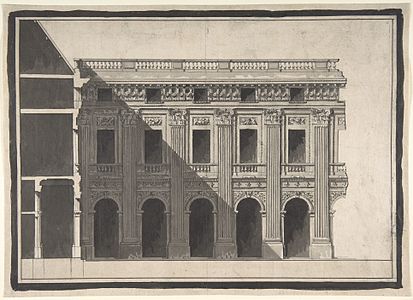


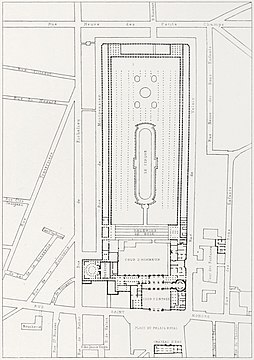


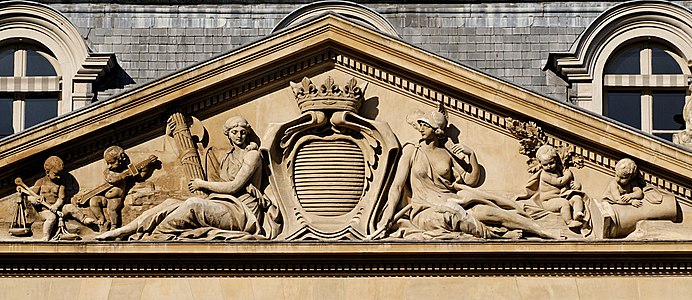






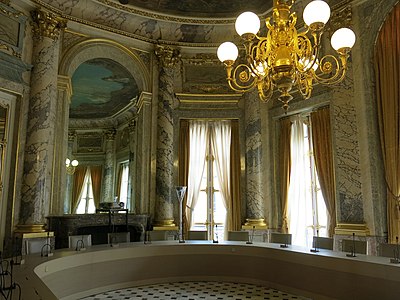
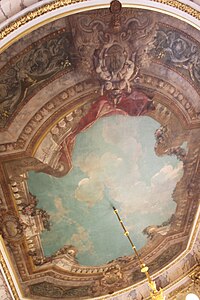



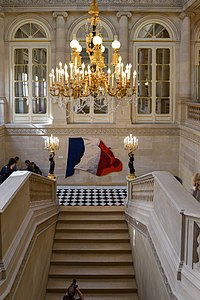








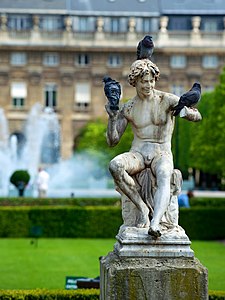







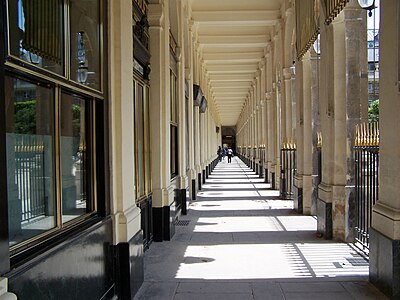









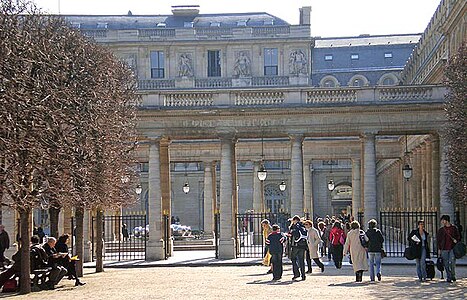
![Dancers of the Nathalie Pernette company perform her dance piece La Figure du Baiser in May 2017 within the Columns of Buren at the Palais-Royal.[56]](http://upload.wikimedia.org/wikipedia/commons/thumb/d/d4/Dancers_in_the_Buren_installation.jpg/401px-Dancers_in_the_Buren_installation.jpg)
